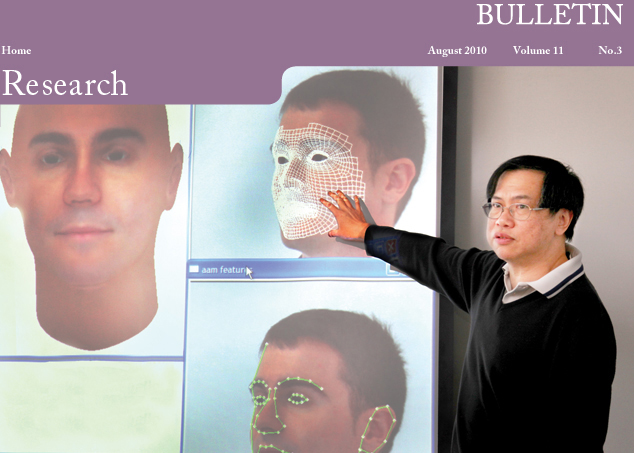

Crime conscious scholars have developed
a state-of-the-art facial recognition system
that could help law enforcement officers
correctly identify suspects partially caught
on surveillance video.
The technology, developed by a five-man team in the Centre for Information Security and Cryptography, can detect and extract the features of a partial face caught on video and reconstruct a three dimensional model of the face, eliminating hours of manual labour and potential human error.
Associate Director of the Centre, Dr Chow Kam-pui who led the team with funding of $1 million from the Innovation and Technology Fund, said, "In normal cases of facial recognition we usually have a frontal view of the face, like when you go through Immigration, but in this case the face has to be in the right position for the computer to recognize it. If not, it will tell you it does not correspond to the full frontal image on the database and therefore is not the same person. This is problematic.
"Again, many surveillance videos of people often do not capture full frontal images and, in terms of law enforcement, this means trawling through hours of footage manually, which is time consuming and the quality may not be good so the recognition rate is low. What we are suggesting is automating the system so that if law enforcement officers have to go through surveillance video searching for a suspect they do not have to do it manually. It can be automated and thus save time and eliminate human error.
"The idea we are using is quite interesting. The basis is a generic three-dimensional image of the head which can be manipulated to produce a full-frontal 3D image from the available photograph, giving us a very good match. This is new to the commercial market. We can reconstruct the hidden part of the face to create a full face, and this gives a 90 per cent match.
At the current stage, the system is used on digital CCTV cameras, rather than the analogue ones which are still the norm. However, the team's demonstration prototype has attracted much attention, including a visit from a team of Hong Kong Immigration officers.
Dr Chow and his colleagues are now in talks with manufacturers to integrate the software into existing face-recognition systems.
The technology, developed by a five-man team in the Centre for Information Security and Cryptography, can detect and extract the features of a partial face caught on video and reconstruct a three dimensional model of the face, eliminating hours of manual labour and potential human error.
Associate Director of the Centre, Dr Chow Kam-pui who led the team with funding of $1 million from the Innovation and Technology Fund, said, "In normal cases of facial recognition we usually have a frontal view of the face, like when you go through Immigration, but in this case the face has to be in the right position for the computer to recognize it. If not, it will tell you it does not correspond to the full frontal image on the database and therefore is not the same person. This is problematic.
"Again, many surveillance videos of people often do not capture full frontal images and, in terms of law enforcement, this means trawling through hours of footage manually, which is time consuming and the quality may not be good so the recognition rate is low. What we are suggesting is automating the system so that if law enforcement officers have to go through surveillance video searching for a suspect they do not have to do it manually. It can be automated and thus save time and eliminate human error.
"The idea we are using is quite interesting. The basis is a generic three-dimensional image of the head which can be manipulated to produce a full-frontal 3D image from the available photograph, giving us a very good match. This is new to the commercial market. We can reconstruct the hidden part of the face to create a full face, and this gives a 90 per cent match.
At the current stage, the system is used on digital CCTV cameras, rather than the analogue ones which are still the norm. However, the team's demonstration prototype has attracted much attention, including a visit from a team of Hong Kong Immigration officers.
Dr Chow and his colleagues are now in talks with manufacturers to integrate the software into existing face-recognition systems.